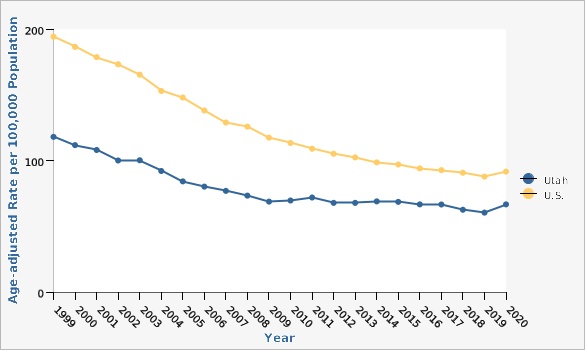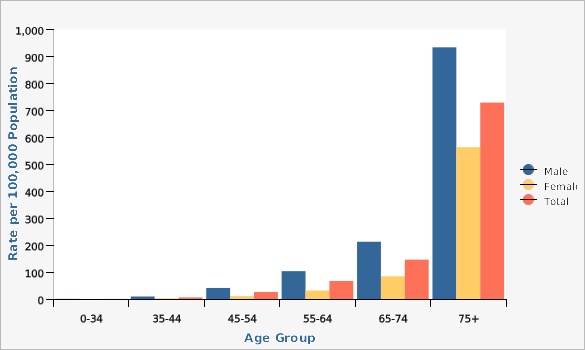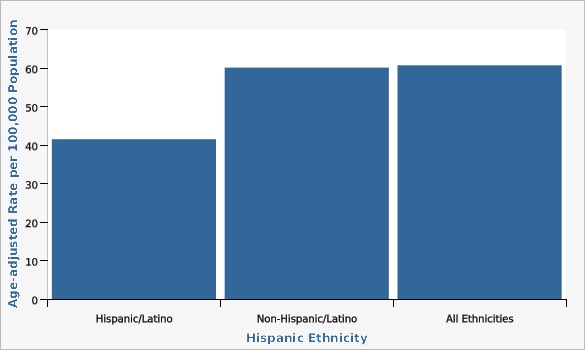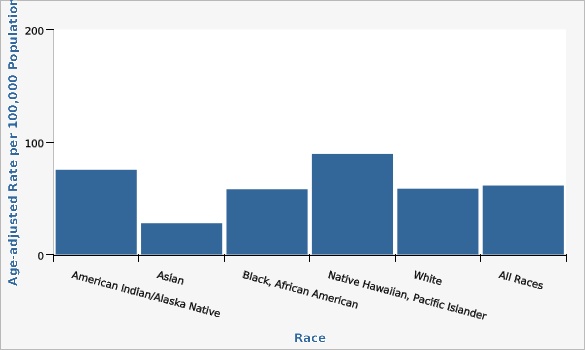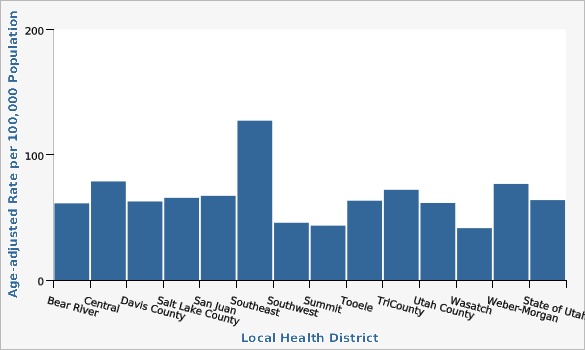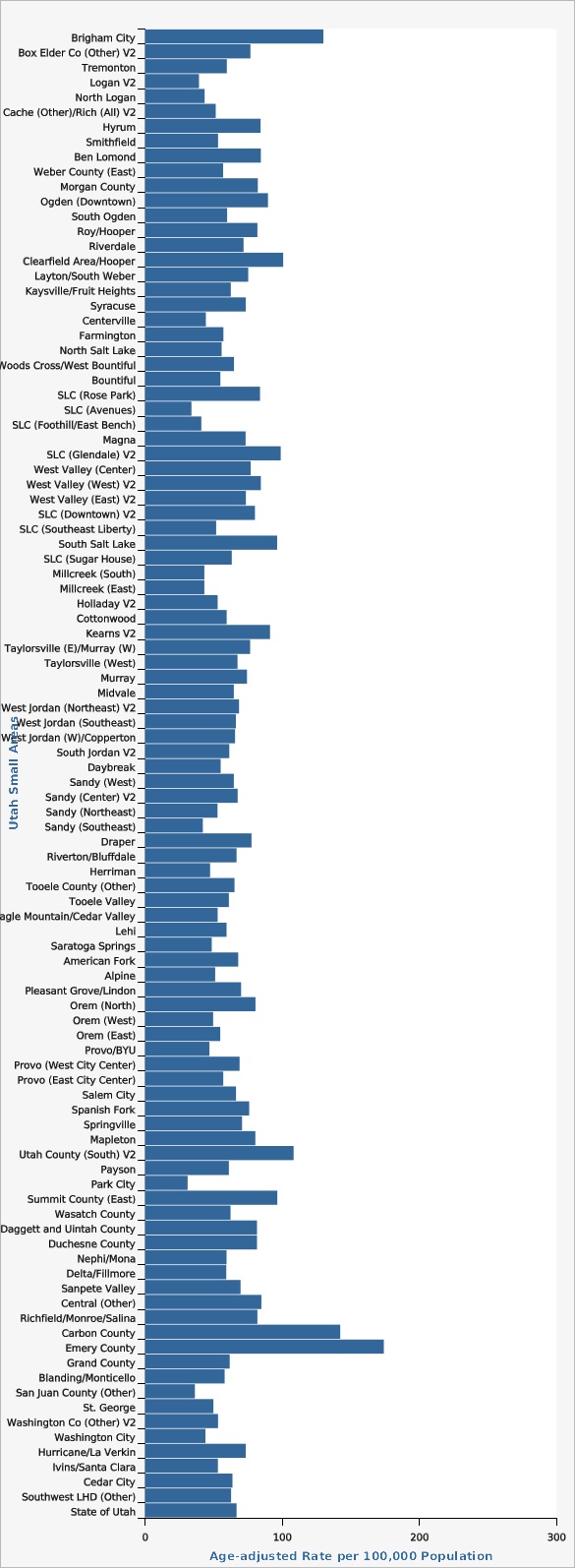Complete Health Indicator Report of Ischemic Heart Disease Deaths
Definition
The rate of coronary heart disease-related deaths per 100,000 population.Numerator
The number of deaths with ICD-10 codes I20-I25 listed as primary cause.Denominator
Total midyear resident population for the same calendar year.Data Interpretation Issues
Please note that for some data views, 11 age categories are used for age adjusting, and in some cases (race, ethnicity), 3 age categories are used. Some views may have a different "overall" rate than the rate shown on the U.S./Utah graph. Some data views use combined years to obtain more reliable estimates, also affecting the value for the overall rate.Why Is This Important?
Ischemic heart disease (sometimes called coronary heart disease or coronary artery disease) is a condition in which blood flow to the heart is reduced. A common cause of this condition is a buildup of plaque in the arteries. When the coronary arteries become narrowed or clogged, an inadequate amount of blood oxygen reaches the heart tissue.Healthy People Objective HDS-2:
Reduce coronary heart disease deathsU.S. Target: 103.4 deaths per 100,000 population
State Target: 54.0 deaths per 100,000 population
Other Objectives
[https://www.cste.org/group/CDIndicators Council of State and Territorial Epidemiologists - Chronic Disease Indicators]How Are We Doing?
In 2020, the age-adjusted mortality rate for ischemic heart disease in Utah was 66.9 deaths per 100,000 population. In 1999 (the year ICD-10 codes began to be used for death records), the age-adjusted rate was 118.3 per 100,000. This shows a decline in mortality rates as a result of ischemic heart disease in Utah between 1999 and 2020.How Do We Compare With the U.S.?
The Utah age-adjusted mortality rate for ischemic heart disease for 2020 was 66.9 per 100,000 population. In contrast, the rate for the U.S. for 2019 (the latest available data at this time) was 88.0 per 100,000 population.What Is Being Done?
HEAL aims to reduce the incidence of diabetes, heart disease, and stroke by targeting risk factors including reducing obesity, increasing physical activity and nutritious food consumption, and improving diabetes and hypertension control. HEAL is part of the Utah Million Hearts Coalition. [https://millionhearts.hhs.gov/index.html Million Hearts 2027] is an initiative co-led by the Centers for Disease Control and Prevention and the Centers for Medicare and Medicaid Services. Million Hearts aimed to reduce the number of heart attacks and strokes in the U.S. by 1 million by 2027. The Utah Million Hearts Coalition has initiated efforts to educate staff in primary care clinics on the proper techniques for measuring high blood pressure. HEAL is also working on the following things to address issues related to high blood cholesterol: *Increasing healthy nutrition and physical activity environments in K-12 schools *Increasing healthy nutrition and physical activity environments in early care and education (childcare/preschool) *Increasing healthy nutrition and physical activity environments and programs in worksites *Improving awareness of prediabetes, hypertension, and high blood cholesterol for Utahns *Improving the quality of medical care for people with diabetes, hypertension, and high blood cholesterol *Improving the linkages between health care providers and supporting community programs for Utahns with prediabetes, diabetes, hypertension, and high blood cholesterol *Improving access and availability to community health programs for Utahns with prediabetes, diabetes, hypertension, and high blood cholesterol *Improving care and management of students with chronic conditions in Utah schoolsAvailable Services
[https://dhhs.utah.gov/ The Utah Department of Health and Human Services] has a Health Resource hotline: 1-888- 222-2542. Please call this number or 211 for information about self-management programs in Utah. [https://www.heart.org/ American Heart Association] 1937 S. 300 W. #120 Salt Lake City, UT 84115 (801) 484-3838 or 1-800-242-8721Health Program Information
The Utah Department of Health and Human Services, Healthy Environments Active Living program plays a key role in improving the health of residents in the state of Utah. The program was formed in July 2013 (as EPICC), through a new funding opportunity from the Centers of Disease Control and Prevention (CDC) that allowed for the merging of three previously existing programs: the Heart Disease and Stroke Prevention Program, the Diabetes Prevention and Control Program, and the Physical Activity, Nutrition and Obesity Program, as well as the addition of a school health program. The Healthy Environments Active Living Program (HEAL) was recently restructured as part of this strategic planning process and the new program model focuses on working together with staff and partners to address the social determinants of health while advancing health equity and increasing policy, systems and environment changes. HEAL champions public health initiatives and addresses the challenges of making health awareness and access truly universal and equitable in eight key areas: nutrition, heart health, diabetes, physical activity, schools, child care, community health workers, and worksites. Visit [https://heal.health.utah.gov/ HEAL?s website] for more information.Related Indicators
Relevant Population Characteristics
Age, gender, and socioeconomic risk factors are related to ischemic heart disease deaths. Advanced age is the major risk factor for ischemic heart disease deaths. Men have a higher ischemic heart disease death rate than women in all age groups. Rates tend to be lowest for Utahns who identify as Asian.Related Relevant Population Characteristics Indicators:
- Utah Population Characteristics: Age Distribution of the Population
- Utah Population Characteristics: Household Income
- Utah Health Improvement Index (HII)
- Utah Population Characteristics: Per Capita Income
- Utah Population Characteristics: Poverty, All Persons
- Utah Population Characteristics: Racial and Ethnic Composition of the Population
Health Care System Factors
Advances in medical technology and clinical care have contributed significantly to the overall decline in ischemic heart disease mortality in the U.S. since 1980. Further decline could be achieved through improved treatment of high blood pressure and diabetes in primary care.Related Health Care System Factors Indicators:
- Blood Cholesterol Screening
- Cost as a barrier to health care
- Diabetes Hemoglobin A1C Tests
- EMS Response Time
- HEDIS (Healthcare Effectiveness Data and Information Set) Measures: Diabetes Care - Hemoglobin A1c (A1C)
- Health Insurance Coverage
- Personal doctor or health care provider
- Routine medical care visits
Risk Factors
Individuals who smoke cigarettes, have high blood pressure, elevated cholesterol, diabetes, poor nutrition, a family history of heart disease, or who are overweight, obese, or physically inactive are at great risk of developing ischemic heart disease.Related Risk Factors Indicators:
- Daily Fruit Consumption
- Daily Vegetable Consumption
- Blood Cholesterol: Doctor-diagnosed High Cholesterol
- Smoking Among Adults
- Diabetes Prevalence
- Fair/poor health
- Blood Pressure: Doctor-diagnosed Hypertension
- Obesity Among Adults
- Overweight or Obese
- Physical Activity: Recommended Aerobic Activity Among Adults
- Physical Activity Among Adolescents
- Prediabetes
Health Status Outcomes
Ischemic heart disease is a chronic condition in which atherosclerosis develops in the coronary arteries that supply blood to the heart muscle.Related Health Status Outcomes Indicators:
Graphical Data Views
In 2020, the age-adjusted rate for Utah was 66.9 deaths per 100,000 people. In 2020, the age-adjusted rate for the U.S. (91.8 per 100,000) was much higher than the rate for Utah.
| Utah vs. U.S. | Year | Age-adjusted Rate per 100,000 Population | Lower Limit | Upper Limit | ||
|---|---|---|---|---|---|---|
Record Count: 44 | ||||||
| Utah | 1999 | 118.3 | 112.7 | 124.0 | ||
| Utah | 2000 | 112.0 | 106.8 | 117.5 | ||
| Utah | 2001 | 108.3 | 103.2 | 113.7 | ||
| Utah | 2002 | 100.3 | 95.4 | 105.3 | ||
| Utah | 2003 | 100.5 | 96.0 | 105.5 | ||
| Utah | 2004 | 92.3 | 87.7 | 97.0 | ||
| Utah | 2005 | 84.4 | 80.1 | 88.9 | ||
| Utah | 2006 | 80.4 | 76.3 | 84.7 | ||
| Utah | 2007 | 77.1 | 73.2 | 81.2 | ||
| Utah | 2008 | 73.5 | 69.7 | 77.5 | ||
| Utah | 2009 | 69.0 | 65.4 | 72.8 | ||
| Utah | 2010 | 69.8 | 66.2 | 73.6 | ||
| Utah | 2011 | 72.1 | 68.5 | 75.8 | ||
| Utah | 2012 | 68.0 | 64.5 | 71.6 | ||
| Utah | 2013 | 68.0 | 64.6 | 71.6 | ||
| Utah | 2014 | 69.1 | 65.7 | 72.6 | ||
| Utah | 2015 | 68.8 | 65.5 | 72.3 | ||
| Utah | 2016 | 66.9 | 63.6 | 70.2 | ||
| Utah | 2017 | 66.8 | 63.7 | 70.2 | ||
| Utah | 2018 | 62.8 | 59.7 | 66.0 | ||
| Utah | 2019 | 60.5 | 57.6 | 63.6 | ||
| Utah | 2020 | 66.9 | 63.8 | 70.0 | ||
| U.S. | 1999 | 194.6 | 194.1 | 195.1 | ||
| U.S. | 2000 | 186.8 | 186.2 | 187.3 | ||
| U.S. | 2001 | 179.0 | 178.5 | 179.5 | ||
| U.S. | 2002 | 173.5 | 173.0 | 174.0 | ||
| U.S. | 2003 | 165.6 | 165.1 | 166.0 | ||
| U.S. | 2004 | 153.2 | 152.8 | 153.7 | ||
| U.S. | 2005 | 148.2 | 147.7 | 148.6 | ||
| U.S. | 2006 | 138.3 | 137.9 | 138.7 | ||
| U.S. | 2007 | 129.2 | 128.8 | 129.6 | ||
| U.S. | 2008 | 126.1 | 125.7 | 126.5 | ||
| U.S. | 2009 | 117.7 | 117.3 | 118.1 | ||
| U.S. | 2010 | 113.6 | 113.3 | 114.0 | ||
| U.S. | 2011 | 109.2 | 108.8 | 109.5 | ||
| U.S. | 2012 | 105.4 | 105.1 | 105.8 | ||
| U.S. | 2013 | 102.6 | 102.3 | 103.0 | ||
| U.S. | 2014 | 98.8 | 98.5 | 99.1 | ||
| U.S. | 2015 | 97.2 | 96.9 | 97.6 | ||
| U.S. | 2016 | 94.3 | 94.0 | 94.6 | ||
| U.S. | 2017 | 92.9 | 92.6 | 93.2 | ||
| U.S. | 2018 | 90.9 | 90.6 | 91.2 | ||
| U.S. | 2019 | 88.0 | 87.7 | 88.3 | ||
| U.S. | 2020 | 91.8 | 91.5 | 92.1 | ||
Data Notes
This indicator uses ICD-10 codes for ischemic heart disease, ICD-10 code I20-I25. Note that this indicator was formerly called coronary heart disease deaths. After a review by the HEAL Program, it was determined ischemic heart disease was a better term and matches the CDC coding. The name of the indicator has been changed to "Ischemic Heart Disease Deaths" (see https://www.ncbi.nlm.nih.gov/books/NBK209964/). [[br]] [[br]] Data reflects deaths with ICD-10 codes I20-I25 listed as primary cause. Utah rates are age-adjusted to 2000 U.S. standard population using 11 age categories and drawn from IBIS-Q. U.S. rates are drawn from CDC WONDER and may use different age-adjustment categories. Centers for Disease Control and Prevention, National Center for Health Statistics. Compressed Mortality File 1999-2020. CDC WONDER On-line Database, compiled from Compressed Mortality File. Accessed at https://wonder.cdc.gov/ucd-icd10.html.Data Sources
- Utah Death Certificate Database, Office of Vital Records and Statistics, Utah Department of Health
- Population Estimates: National Center for Health Statistics (NCHS) through a collaborative agreement with the U.S. Census Bureau, IBIS Version 2018
- U.S. Centers for Disease Control and Prevention, on-line data - CDC WONDER
- National Vital Statistics System, National Center for Health Statistics, U.S. Centers for Disease Control and Prevention
For years 2018-2020, death rates were dramatically higher for Utahns aged 75 and older. Males in Utah have higher death rates from ischemic heart disease than females among all age groups.
| Males vs. Females | Age Group | Rate per 100,000 Population | Lower Limit | Upper Limit | Note | |
|---|---|---|---|---|---|---|
Record Count: 34 | ||||||
| Male | 0-34 | 0.5 | 0.3 | 0.9 | ||
| Male | 35-44 | 9.3 | 7.2 | 11.9 | ||
| Male | 45-54 | 41.0 | 35.6 | 47.0 | ||
| Male | 55-64 | 103.3 | 94.1 | 113.2 | ||
| Male | 65-74 | 212.5 | 196.7 | 229.2 | ||
| Male | 75+ | 933.9 | 891.5 | 977.9 | ||
| Female | 0-34 | 0.3 | 0.1 | 0.6 | * Interpret with caution | |
| Female | 35-44 | 2.5 | 1.4 | 4.0 | ||
| Female | 45-54 | 10.7 | 8.0 | 14.0 | ||
| Female | 55-64 | 31.6 | 26.7 | 37.2 | ||
| Female | 65-74 | 84.4 | 74.9 | 94.7 | ||
| Female | 75+ | 563.3 | 533.8 | 594.0 | ||
| Total | 0-34 | 0.4 | 0.3 | 0.6 | ||
| Total | 35-44 | 5.9 | 4.7 | 7.4 | ||
| Total | 45-54 | 26.0 | 23.0 | 29.4 | ||
| Total | 55-64 | 66.8 | 61.6 | 72.4 | ||
| Total | 65-74 | 146.0 | 136.9 | 155.5 | ||
| Total | 75+ | 728.6 | 703.5 | 754.3 | ||
Data Notes
This indicator uses ICD-10 codes for ischemic heart disease, ICD-10 code I20-I25. Note that this indicator was formerly called coronary heart disease deaths. After a review by the HEAL Program, it was determined ischemic heart disease was a better term and matches the CDC coding. The name of the indicator has been changed to "Ischemic Heart Disease Deaths" (see https://www.ncbi.nlm.nih.gov/books/NBK209964/). [[br]] [[br]] *Use caution in interpreting; the estimate has a coefficient of variation > 30% and is unreliable.Data Sources
- Population Estimates: National Center for Health Statistics (NCHS) through a collaborative agreement with the U.S. Census Bureau, IBIS Version 2018
- Utah Death Certificate Database, Office of Vital Records and Statistics, Utah Department of Health
In 2020, the death rate for ischemic heart disease among Hispanic Utahns (47.2 per 100,000) was lower than the rate among the general Utah population (61.7 per 100,000) The rate for non-Hispanics was 62.4.
| Hispanic Ethnicity | Age-adjusted Rate per 100,000 Population | Lower Limit | Upper Limit | |||
|---|---|---|---|---|---|---|
Record Count: 3 | ||||||
| Hispanic/Latino | 41.5 | 33.5 | 50.9 | |||
| Non-Hispanic/Latino | 60.1 | 57.3 | 63.0 | |||
| All Ethnicities | 60.7 | 58.0 | 63.5 | |||
Data Notes
This indicator uses ICD-10 codes for ischemic heart disease, ICD-10 code I20-I25. Note that this indicator was formerly called coronary heart disease deaths. After a review by the HEAL Program, it was determined ischemic heart disease was a better term and matches the CDC coding. The name of the indicator has been changed to "Ischemic Heart Disease Deaths" (see https://www.ncbi.nlm.nih.gov/books/NBK209964/). [[br]] [[br]] Rates are age-adjusted to the 2000 U.S. standard population using three age categories. Numbers for each age group may vary widely from year to year, making the comparisons less stable. Using fewer age groups helps to minimize this type of variation. See Data Interpretation Issues for additional information.Data Sources
- Utah Death Certificate Database, Office of Vital Records and Statistics, Utah Department of Health
- Population Estimates by Age, Sex, Race, and Hispanic Origin for Counties in Utah, U.S. Bureau of the Census, IBIS Version 2018
For 2021, the age-adjusted ischemic heart disease death rate was lowest among the Asian population (27.8 per 100,000) compared to all races ( 61.3 per 100,000). The highest rate was seen for Pacific Islanders, with a rate of 89.4 per 100,000 population. American Indians/Native Alaskans had the second highest rate for ischemic heart disease deaths in Utah, with a rate of 75.3 per 100,1000 population.
| Race | Age-adjusted Rate per 100,000 Population | Lower Limit | Upper Limit | |||
|---|---|---|---|---|---|---|
Record Count: 6 | ||||||
| American Indian/Alaska Native | 75.3 | 48.1 | 112.3 | |||
| Asian | 27.8 | 16.9 | 43.1 | |||
| Black, African American | 58.0 | 32.2 | 96.2 | |||
| Native Hawaiian, Pacific Islander | 89.4 | 53.9 | 139.4 | |||
| White | 58.5 | 55.8 | 61.4 | |||
| All Races | 61.3 | 58.5 | 64.1 | |||
Data Notes
This indicator uses ICD-10 codes for ischemic heart disease, ICD-10 code I20-I25. Note that this indicator was formerly called coronary heart disease deaths. After a review by the HEAL Program, it was determined ischemic heart disease was a better term and matches the CDC coding. The name of the indicator has been changed to "Ischemic Heart Disease Deaths" (see https://www.ncbi.nlm.nih.gov/books/NBK209964/). [[br]] [[br]] Rates are age-adjusted to the 2000 U.S. standard population using three age categories.Data Sources
- Utah Death Certificate Database, Office of Vital Records and Statistics, Utah Department of Health
- Population Estimates by Age, Sex, Race, and Hispanic Origin for Counties in Utah, U.S. Bureau of the Census, IBIS Version 2018
The local health district with the highest ischemic heart disease death rate was Southeast Utah (127.2 per 100,000 population). The district with the lowest rate was Wasatch County (41.4 per 100,000 population).
| Local Health District | Age-adjusted Rate per 100,000 Population | Lower Limit | Upper Limit | |||
|---|---|---|---|---|---|---|
Record Count: 14 | ||||||
| Bear River | 61.2 | 52.7 | 70.6 | |||
| Central | 78.7 | 66.1 | 92.8 | |||
| Davis County | 62.7 | 56.2 | 69.8 | |||
| Salt Lake County | 65.6 | 62.0 | 69.4 | |||
| San Juan | 67.2 | 42.5 | 101.2 | |||
| Southeast | 127.2 | 106.1 | 151.2 | |||
| Southwest | 45.7 | 40.8 | 51.1 | |||
| Summit | 43.4 | 28.5 | 63.4 | |||
| Tooele | 63.3 | 48.2 | 81.6 | |||
| TriCounty | 72.0 | 56.3 | 90.7 | |||
| Utah County | 61.5 | 56.0 | 67.4 | |||
| Wasatch | 41.4 | 25.4 | 63.8 | |||
| Weber-Morgan | 76.7 | 69.1 | 85.0 | |||
| State of Utah | 63.8 | 61.7 | 66.0 | |||
Data Notes
This indicator uses ICD-10 codes for ischemic heart disease, ICD-10 code I20-I25. Note that this indicator was formerly called coronary heart disease deaths. After a review by the HEAL Program, it was determined ischemic heart disease was a better term and matches the CDC coding. The name of the indicator has been changed to "Ischemic Heart Disease Deaths" (see https://www.ncbi.nlm.nih.gov/books/NBK209964/). [[br]] [[br]] Rates are age-adjusted to the 2000 U.S. standard population using 11 age categories.Data Sources
- Population Estimates: National Center for Health Statistics (NCHS) through a collaborative agreement with the U.S. Census Bureau, IBIS Version 2020
- Utah Death Certificate Database, Office of Vital Records and Statistics, Utah Department of Health
For years 2016-2020, Carbon and Emery counties had high rates of deaths from ischemic heart disease, 143.4 and 145.3, respectively.
| County | Age-adjusted Rate per 100,000 Population | Lower Limit | Upper Limit | Note | ||
|---|---|---|---|---|---|---|
Record Count: 30 | ||||||
| Beaver | 43.1 | 23.1 | 73.5 | |||
| Box Elder | 98.8 | 87.1 | 111.5 | |||
| Cache | 45.6 | 39.6 | 52.2 | |||
| Carbon | 143.4 | 123.0 | 166.3 | |||
| Daggett | 51.4 | 16.3 | 121.6 | *Unreliable estimate | ||
| Davis | 66.3 | 62.0 | 70.9 | |||
| Duchesne | 76.8 | 59.7 | 97.4 | |||
| Emery | 145.3 | 116.4 | 179.2 | |||
| Garfield | 72.3 | 47.8 | 105.0 | |||
| Grand | 58.6 | 41.3 | 80.7 | |||
| Iron | 61.2 | 51.4 | 72.4 | |||
| Juab | 72.2 | 50.0 | 100.9 | |||
| Kane | 74.0 | 51.7 | 102.7 | |||
| Millard | 60.9 | 45.2 | 80.3 | |||
| Morgan | 78.1 | 54.3 | 108.7 | |||
| Piute | 99.5 | 48.2 | 181.9 | |||
| Rich | 55.6 | 25.3 | 106.0 | *Unreliable estimate | ||
| Salt Lake | 64.8 | 62.5 | 67.2 | |||
| San Juan | 50.9 | 36.6 | 69.0 | |||
| Sanpete | 72.9 | 59.6 | 88.4 | |||
| Sevier | 75.6 | 60.8 | 92.8 | |||
| Summit | 48.8 | 37.5 | 62.4 | |||
| Tooele | 61.8 | 52.0 | 72.8 | |||
| Uintah | 78.2 | 64.3 | 94.1 | |||
| Utah | 61.6 | 58.0 | 65.4 | |||
| Wasatch | 61.6 | 47.6 | 78.6 | |||
| Washington | 48.4 | 44.6 | 52.5 | |||
| Wayne | 62.5 | 31.6 | 111.0 | |||
| Weber | 77.5 | 72.4 | 82.9 | |||
| State | 64.9 | 63.5 | 66.3 | |||
Data Notes
This indicator uses ICD-10 codes for ischemic heart disease, ICD-10 code I20-I25. Note that this indicator was formerly called coronary heart disease deaths. After a review by the HEAL Program, it was determined ischemic heart disease was a better term and matches the CDC coding. The name of the indicator has been changed to "Ischemic Heart Disease Deaths" (see https://www.ncbi.nlm.nih.gov/books/NBK209964/). [[br]] [[br]] Unreliable estimates: The rates for Daggett and Rich Counties have relative standard errors greater than 30% and should be interpreted with caution. These estimates do not meet UDOH standards for reliability. Rates are age-adjusted to the 2000 U.S. standard population using 11 age categories.Data Sources
- Utah Death Certificate Database, Office of Vital Records and Statistics, Utah Department of Health
- Population Estimates: National Center for Health Statistics (NCHS) through a collaborative agreement with the U.S. Census Bureau, IBIS Version 2018
The Utah Small Area with the highest ischemic heart disease death rates was Emery County at 174.2 per 100,000 people. The lowest rate, 31.1 per 100,000 people, was seen for Park City. Note that the rate for San Juan (Other) should be interpreted with caution as small numbers make the result unreliable.
| Utah Small Areas | Age-adjusted Rate per 100,000 Population | Lower Limit | Upper Limit | Note | ||
|---|---|---|---|---|---|---|
Record Count: 101 | ||||||
| Brigham City | 130.1 | 111.2 | 151.4 | |||
| Box Elder Co (Other) V2 | 76.9 | 54.8 | 104.9 | |||
| Tremonton | 59.7 | 43.3 | 80.3 | |||
| Logan V2 | 39.4 | 31.1 | 49.3 | |||
| North Logan | 43.5 | 30.5 | 60.2 | |||
| Cache (Other)/Rich (All) V2 | 51.6 | 38.1 | 68.3 | |||
| Hyrum | 84.3 | 50.7 | 131.7 | |||
| Smithfield | 53.3 | 34.8 | 78.2 | |||
| Ben Lomond | 84.5 | 73.6 | 96.6 | |||
| Weber County (East) | 57.0 | 46.5 | 69.2 | |||
| Morgan County | 82.3 | 57.7 | 114.0 | |||
| Ogden (Downtown) | 89.7 | 74.7 | 106.9 | |||
| South Ogden | 59.9 | 49.9 | 71.2 | |||
| Roy/Hooper | 82.0 | 69.6 | 96.0 | |||
| Riverdale | 71.9 | 58.9 | 87.0 | |||
| Clearfield Area/Hooper | 100.8 | 86.5 | 116.7 | |||
| Layton/South Weber | 75.3 | 65.3 | 86.4 | |||
| Kaysville/Fruit Heights | 62.6 | 50.0 | 77.4 | |||
| Syracuse | 73.5 | 51.4 | 102.0 | |||
| Centerville | 44.4 | 31.7 | 60.4 | |||
| Farmington | 57.2 | 41.2 | 77.2 | |||
| North Salt Lake | 55.9 | 38.1 | 79.1 | |||
| Woods Cross/West Bountiful | 64.9 | 39.6 | 100.4 | |||
| Bountiful | 55.0 | 47.4 | 63.5 | |||
| SLC (Rose Park) | 83.9 | 68.0 | 102.5 | |||
| SLC (Avenues) | 33.9 | 25.2 | 44.6 | |||
| SLC (Foothill/East Bench) | 41.1 | 31.5 | 52.6 | |||
| Magna | 73.4 | 54.7 | 96.4 | |||
| SLC (Glendale) V2 | 99.0 | 77.6 | 124.4 | |||
| West Valley (Center) | 77.1 | 64.3 | 91.6 | |||
| West Valley (West) V2 | 84.5 | 60.6 | 114.8 | |||
| West Valley (East) V2 | 73.6 | 61.1 | 88.0 | |||
| SLC (Downtown) V2 | 80.2 | 67.2 | 95.1 | |||
| SLC (Southeast Liberty) | 51.9 | 37.6 | 69.9 | |||
| South Salt Lake | 96.4 | 78.5 | 117.2 | |||
| SLC (Sugar House) | 63.3 | 52.7 | 75.5 | |||
| Millcreek (South) | 43.3 | 34.2 | 54.1 | |||
| Millcreek (East) | 43.3 | 34.2 | 54.1 | |||
| Holladay V2 | 53.0 | 43.9 | 63.4 | |||
| Cottonwood | 59.6 | 51.0 | 69.2 | |||
| Kearns V2 | 91.2 | 73.4 | 111.9 | |||
| Taylorsville (E)/Murray (W) | 76.7 | 63.6 | 91.6 | |||
| Taylorsville (West) | 67.5 | 54.5 | 82.7 | |||
| Murray | 74.4 | 62.6 | 87.8 | |||
| Midvale | 64.8 | 52.0 | 79.7 | |||
| West Jordan (Northeast) V2 | 68.6 | 53.1 | 87.2 | |||
| West Jordan (Southeast) | 66.3 | 51.1 | 84.7 | |||
| West Jordan (W)/Copperton | 65.7 | 45.3 | 92.1 | |||
| South Jordan V2 | 61.5 | 50.1 | 74.6 | |||
| Daybreak | 55.2 | 34.0 | 84.7 | |||
| Sandy (West) | 64.8 | 52.1 | 79.7 | |||
| Sandy (Center) V2 | 67.6 | 53.5 | 84.4 | |||
| Sandy (Northeast) | 52.9 | 40.5 | 67.8 | |||
| Sandy (Southeast) | 42.2 | 30.7 | 56.7 | |||
| Draper | 77.7 | 61.2 | 97.2 | |||
| Riverton/Bluffdale | 66.8 | 52.3 | 84.0 | |||
| Herriman | 47.5 | 30.7 | 70.1 | |||
| Tooele County (Other) | 65.3 | 45.7 | 90.5 | |||
| Tooele Valley | 61.2 | 50.1 | 73.9 | |||
| Eagle Mountain/Cedar Valley | 53.0 | 28.4 | 90.1 | |||
| Lehi | 59.5 | 46.5 | 75.0 | |||
| Saratoga Springs | 48.7 | 27.9 | 78.9 | |||
| American Fork | 68.0 | 55.7 | 82.3 | |||
| Alpine | 51.2 | 31.5 | 78.5 | |||
| Pleasant Grove/Lindon | 70.1 | 57.9 | 84.0 | |||
| Orem (North) | 80.6 | 65.3 | 98.5 | |||
| Orem (West) | 49.7 | 38.0 | 63.9 | |||
| Orem (East) | 54.9 | 42.3 | 70.2 | |||
| Provo/BYU | 47.0 | 37.9 | 57.7 | |||
| Provo (West City Center) | 69.0 | 52.1 | 89.7 | |||
| Provo (East City Center) | 57.1 | 36.6 | 85.1 | |||
| Salem City | 66.4 | 42.4 | 99.1 | |||
| Spanish Fork | 76.0 | 60.5 | 94.3 | |||
| Springville | 70.8 | 55.9 | 88.5 | |||
| Mapleton | 80.5 | 52.8 | 117.7 | |||
| Utah County (South) V2 | 108.4 | 76.3 | 149.6 | |||
| Payson | 61.2 | 45.4 | 80.7 | |||
| Park City | 31.1 | 18.6 | 48.7 | |||
| Summit County (East) | 96.5 | 70.2 | 129.3 | |||
| Wasatch County | 62.4 | 48.5 | 79.1 | |||
| Daggett and Uintah County | 81.7 | 67.4 | 98.0 | |||
| Duchesne County | 81.7 | 63.4 | 103.6 | |||
| Nephi/Mona | 59.5 | 37.4 | 90.0 | |||
| Delta/Fillmore | 59.3 | 41.0 | 82.9 | |||
| Sanpete Valley | 69.7 | 53.7 | 88.9 | |||
| Central (Other) | 84.9 | 70.1 | 101.9 | |||
| Richfield/Monroe/Salina | 82.0 | 63.7 | 103.9 | |||
| Carbon County | 142.4 | 122.1 | 165.1 | |||
| Emery County | 174.2 | 139.1 | 215.4 | |||
| Grand County | 61.8 | 43.5 | 85.1 | |||
| Blanding/Monticello | 58.1 | 36.8 | 87.4 | |||
| San Juan County (Other) | 36.4 | 17.6 | 66.7 | *Unreliable estimate | ||
| St. George | 49.9 | 44.6 | 55.7 | |||
| Washington Co (Other) V2 | 53.3 | 38.0 | 72.5 | |||
| Washington City | 44.1 | 33.8 | 56.6 | |||
| Hurricane/La Verkin | 73.5 | 59.4 | 89.8 | |||
| Ivins/Santa Clara | 53.2 | 39.6 | 69.9 | |||
| Cedar City | 63.8 | 52.5 | 76.9 | |||
| Southwest LHD (Other) | 62.8 | 51.3 | 76.1 | |||
| State of Utah | 66.8 | 65.3 | 68.2 | |||
Data Notes
This indicator uses ICD-10 codes for ischemic heart disease, ICD-10 code I20-I25. Note that this indicator was formerly called coronary heart disease deaths. After a review by the HEAL Program, it was determined ischemic heart disease was a better term and matches the CDC coding. The name of the indicator has been changed to "Ischemic Heart Disease Deaths" (see https://www.ncbi.nlm.nih.gov/books/NBK209964/). [[br]] [[br]] Five years of data were combined to increase the reliability of the estimates. Rates are age-adjusted to the 2000 U.S. standard population using 11 age categories. *Unreliable estimates: The rate for San Juan (other) has a relative standard error greater than 30% and should be interpreted with caution. These estimates do not meet UDOH standards for reliability. A description of the Utah Small Areas may be found on the Methodology and Guidelines page: [https://ibis.health.utah.gov/resource/Guidelines.html].Data Sources
- Utah Death Certificate Database, Office of Vital Records and Statistics, Utah Department of Health
- Population estimates produced by the UDOH Center for Health Data and Informatics. Linear interpolation of U.S. Census Bureau and ESRI ZIP Code data provided annual population estimates for ZIP Code areas by sex and age groups, IBIS Version 2018
References and Community Resources
Heart disease is the leading cause of death and is responsible for 1 of every 3 deaths in the country. [https://millionhearts.hhs.gov/ Million Hearts] is a national initiative that has set an ambitious goal to prevent 1 million heart attacks and strokes within 5 years (by 2027). The impact will be even greater over time. Million Hearts aims to prevent heart disease and stroke by: Improving access to effective care. Improving the quality of care for the ABCS (appropriate aspirin prescription, blood pressure control, cholesterol control, and smoking cessation). Focusing clinical attention on the prevention of heart attack and stroke. Activating the public to lead a heart-healthy lifestyle. Improving the prescription and adherence to appropriate medications for the ABCS. Visit https://millionhearts.hhs.gov/ for more information.More Resources and Links
Evidence-based community health improvement ideas and interventions may be found at the following sites:- Centers for Disease Control and Prevention (CDC) WONDER Database, a system for disseminating public health data and information.
- United States Census Bureau data dashboard.
- Utah healthy Places Index, evidence-based and peer-reviewed tool, supports efforts to prioritize equitable community investments, develop critical programs and policies across the state, and much more.
- County Health Rankings
- Kaiser Family Foundation's StateHealthFacts.org
- Medical literature can be queried at PubMed library.
Page Content Updated On 11/29/2022,
Published on 11/30/2022

